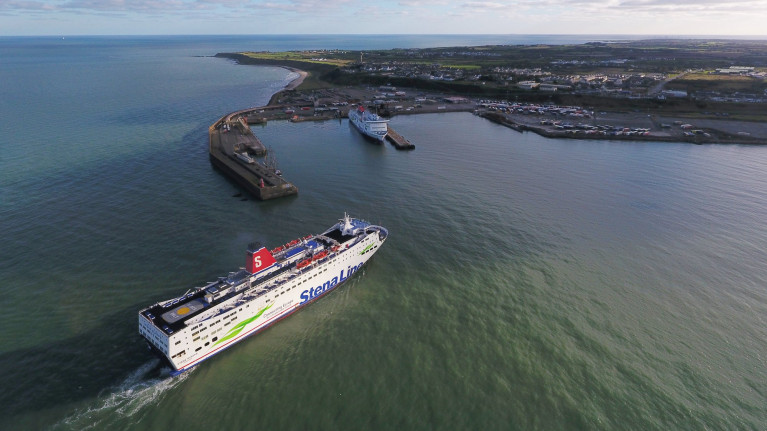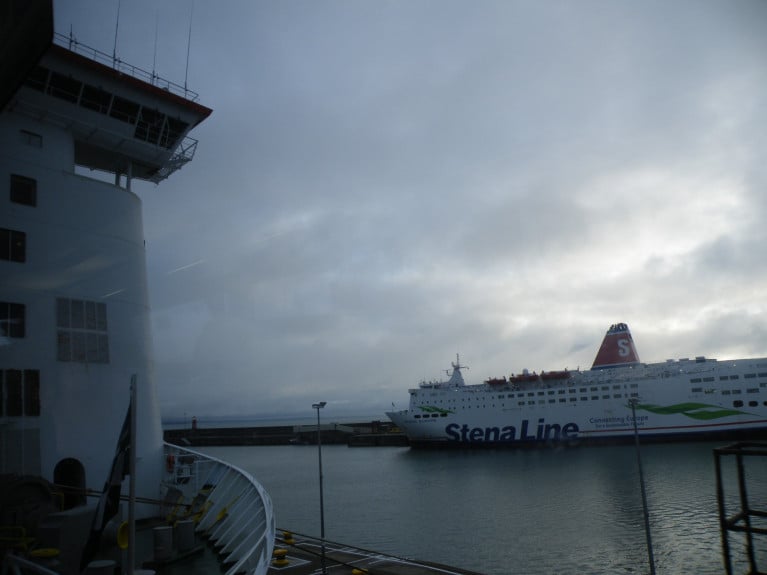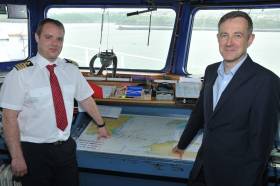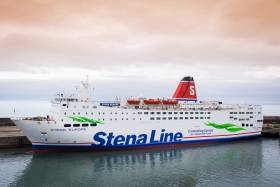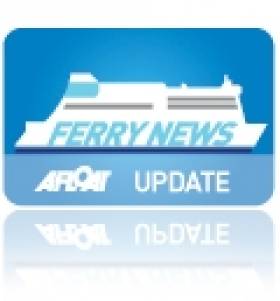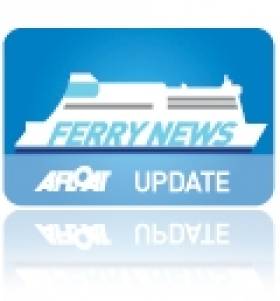Displaying items by tag: RosslareFishguard
Pembrokeshire Ferry to Resume Rosslare Route Service Tonight after Almost Six-Week Absence
Passengers, particularly Welsh rugby fans travelling by ‘foot’ for this Saturday’s match with Ireland, in Dublin, have got good news as the Stena Line owned port of Fishguard is to see their ferry back on the run after a five-and-a-half-week disruption in service.
The south Wales-Ireland route, formerly served until last year by the popular Stena Europe as Afloat referred earlier today, (see related Stena CEO story), will reports the Western Telegraph, travel but from the Irish port of Rosslare to Fishguard at 7.30pm (19.30hrs) this evening on the first crossing in more than a month as the St. Georges Channel ferry service resumes. (At the time of writing, Afloat can confirm the Stena Europe has departed Rosslare).
Stena Europe is being used as a temporary vessel while Fishguard Port undergoes maintenance work to a linkspan berth. The work means that the Stena Nordica, which was announced a year ago as the ‘permanent’ ferry since its introduction in July last year, was operating between Fishguard and Rosslare is unable to berth in Fishguard at the moment.
The ropax ferry since January has been been put on the Dublin to Holyhead route while the work takes place, allowing also for that route’s secondary ferry, Stena Estrid to provide relief cover for the Belfast-Birkenhead E-flexer twins to go for annual overhaul dry-dockings.
The only one ferry that is able to berth at Fishguard in its current configuration is the Stena Europe, however the veteran vessel dating to 1981 had to go for repairs at Cammell Laird, Birkenhead, from where the ferry has been for the most part of these past weeks, then a stint afterwards at Liverpool Docks. Afloat had tracked the ferry relocate having crossed the Mersey with the assistance of a pair of tugs to enable berthing within the docks that would later include shifting to Canada Dock.
Now that the Stena Europe has returned to Fishguard after the long delay due to unforeseen mechanical issues, but Stena has confirmed that the ferry has taken over the route from today.
As previously reported, Stena Europe covered the Fishguard-Rosslare run for 21 years, until 13 July last year followed by a trip to A&P Falmouth that afterwards led to a short charter on the Strait of Gibraltar between Spain and Morocco.
“Stena Line can confirm that Stena Europe will enter service on the Rosslare-Fishguard route at 7.30pm on Tuesday, February 20,” said a company spokesperson. “We apologise for the delay to the resumption of this service, and we look forward to welcoming our customers onboard.”
More on the story here as the Stena Europe will also be a most welcome sight for ferry fans on both sides of the southern corridor route, though the ferry will be replaced again when Stena Nordica makes its presence with a night-sailing departing the Welsh port on St. David’s Day, 1st March.
Afloat however understands Stena Nordica is to be off-service again but on a temporary basis on the Rosslare-Cherbourg route joining the Stena Vision as the Ireland-France route's secondary ferry, ropax Stena Horizon is currently running Stena's new Dublin-Birkenhead 'freight' route but is scheduled to return to the continental service in April.
Operator Stena Line Forced to Suspend Rosslare-Fishguard Route to Plug Gap Left by P&O in Larne
Ferry company Stena Line has been forced to suspend sailings between Rosslare and Fishguard until 12 April, to plug gap left by P&O Ferries between Larne and Cairnryan.
As ITV news reports, P&O’s two ships – the European Causeway and the European Highlander – haven’t sailed on the route since the company sacked all 800 staff on St Patrick’s Day.
It caused a freight backlog on a key route used to bring goods into Northern Ireland.
As a result, Stena Line moved the Stena Nordica onto the route as an extra freight ship from its (temporary) Dublin to Holyhead service.
It was replaced on that route by the Stena Europe – which had been sailing between Rosslare-Fishguard.
Afloat.ie adds Stena Europe has since last month, operated as second ship on the Dublin-Holyhead route along with Stena Adventurer. This led to the route's other routine ferry, Stena Estrid to transfer to the Rosslare-Cherbourg route
While the Ireland-France route ferry Stena Horizon dry-docks at Harland & Wolff, Belfast, as alluded in the ITV coverage which has more.
Rosslare-Fishguard Ferry Sailings Still Suspended
Sailings between Rosslare and Fishguard in south Wales continue to be suspended as the Stena Europe's stay in dry dock is extended to June 4.
As Afloat previously reported, the Irish Sea crossing was temporarily cancelled, initially until May 22.
Stena Line said that it had been decided to send the vessel for repair at the Harland and Wolff shipyard in Belfast, following a routine inspection of the ferry.
It was initially anticipated that the repairs would be completed by May 21 and the ferry back on the run by the 22.
However, the company still has no Irish Sea crossings from Fishguard and (yesterday) confirmed that the Europe's stay in dry dock has been extended.
"Stena Line is continuing to carry out works on the Stena Europe, while travel restrictions with the Republic of Ireland remain in place," said a spokesperson for the company.
"An announcement from the Irish Government is expected (today) Friday, May 28, on Digital Green Certificates and International Travel and Stena Line plans to have the Stena Europe back in service on June 4."
More reports the Western Telegraph here.
In addition earlier today Afloat reported on the Irish Government's position on the Common Travel Area between Ireland and UK.
Operator Stena Cancels Sailings from Welsh Port for a Week As Ferry Transfers to Holyhead Route
Operator Stena Line will cancel all sailings for a week from one Welsh port as a ferry moves to the Holyhead-Dublin route for a temporary period.
The routes between Wales and Ireland have been hit by reduced demand due to post-Brexit trade distortion and national lockdowns.
Now Stena will take the opportunity to undertake its dry-docking programme for annual maintenance.
This will result in a new session of musical ferries on the Irish Sea.
The Stena 'Superfast' VII (see: related story) is going into dry dock and Stena Edda moves to cover the Belfast – Cairnryan route.
Stena Horizon switches from Anglesey to cover Edda on the Birkenhead route and Europe heads from Fishguard to Holyhead to keep two ships on that route.
It will mean sailings between Fishguard-Rosslare are cancelled for just over a week.
But it could mean extra dockers brought back from furlough at Holyhead. They had been placed back on the UK Government scheme due to the impact of Brexit and Covid lockdowns.
More on this reports NorthWalesLive here.
Afloat adds that competitor, Irish Ferries operates the Rosslare-Pembroke route, the second ferry port in south Wales connecting the Wexford port, whose general manager last week made a call for a consolidated ferry service using just one of the Pembrokeshire ports. This to encourage hauliers back into using the ports and the UK land bridge.
In the same week, a Welsh Affairs Committee also heard it would make logistical and economic sense for Pembrokeshire to operate a single ferry port, and possibly served by two companies linking Rosslare Europort which in recent months has seen an explosion in traffic given 'Brexit-Bypass' demand.
#NewTimetable - The launch of the new timetable on Stena Line’s Rosslare – Fishguard route has begun this week. The revised timetable now gives customers the chance to avail of three day sailings and one extended overnight crossing.
The operator have carried out extensive customer research and feedback. In addition to reviewing the previous schedule that has led to the introduction of a more customer friendly timetable which now comprises of three x 3 hour 15 minutes daytime crossings making the route the shortest and fastest crossing between Ireland and South Wales.
Ian Davies, Stena Line’s Trade Director, Irish Sea South commented: “We recently carried out a substantial investment in the Stena Europe vessel and to ensure we make the most of this service for our customers, we carried out extensive research with them to find out how we can provide an even more enjoyable travel experience.
“After analysing the results, we made the decision to amend the timetable on our Rosslare to Fishguard route and are now delighted to offer our customers three day sailings and an extended overnight crossing. This not only creates new opportunities which were not previously available on the market for our travel and freight customers, but also reduces the crossing times on some of our sailings by 15 minutes.”
Stena Line’s sailing schedule between Rosslare and Fishguard is now:
Departure Arrival Crossing Time
Rosslare 08:00 11:15 3hr15
Fishguard 13:10 16:25 3hr15
Rosslare 18:10 21:25 3hr15
Fishguard 23:45 04:00 4hr15*
*Overnight sailing time will increase by 15 minutes giving customers a little more time to rest particularly drivers before they disembark.
Stena Revise Timetable to Refresh Rosslare-Fishguard Route
#Timetable - A revised timetable of Stena Line's Rosslare – Fishguard ferry service will see customers have a choice of three-day time sailings and one extended overnight crossing from 22nd May.
Following the evaluation of extensive customer research and feedback, Stena Line reviewed the existing schedule and has decided to introduce three, more customer friendly 3 hour 15-minute day time crossings, making Rosslare – Fishguard the shortest and fastest crossing between Ireland and South Wales.
From Monday 22nd May, Stena Line will operate the following revised sailing schedule between Rosslare and Fishguard:
Departure Arrival Crossing Time
Rosslare 08:00 11:15 3hr15
Fishguard 13:10 16:25 3hr15
Rosslare 18:10 21:25 3hr15
Fishguard 23:45 04:00 4hr15*
Ian Davies, Stena Line’s Trade Director, Irish Sea South commented: “The new timetable will reduce the crossing times on some of our sailings by 15 mins and provide a greater choice of convenient sailing times and better arrival times. The recent investment in the Stena Europe ship has further enhanced our service offering for 2017, providing new opportunities which currently do not exist in the market for our travel and freight customers.”
Ian added: “We have conducted a lot of research and spoken with many of our freight and travel customers, listening to what they had to say about our current sailing timetable and ways in which we might improve the service in the future. We believe we have now addressed the points raised and our staff are constantly engaging with customers to ensure a smooth transition. In fact, we have already received positive feedback and believe that the vast majority of our customers will welcome these changes.”
*Overnight sailing time will increase by 15 minutes giving customers a little more time to rest particularly drivers before they disembark.
#FerryREFITS – Stena Line's charter of Finnarrow, which as previously reported on Afloat.ie, entered service on the Dublin Port-Holyhead route allowed Stena Nordica to relief the Rosslare-Fishguard ferry, and not as previously indicated go straight to annual refit.
Instead Stena Nordica, has replaced the St. Georges Channel route ferry Stena Europe, which sailed northbound to dry-dock at Harland & Wolff, Belfast. She is sharing the dry-dock with P&O's fast-craft Express, which too is undergoing annual maintenance having shifted berths from Donegall Quay.
The Stena Nordica of 24,206grt, is no stranger to Rosslare, having made an en-route call on certain weekend's while running P&O's Dublin Port-Cherbourg route as the European Ambassador, until the route closed in 2004.
Stena Line to Mark History of Wartime Bombed Ferry
#FERRY NEWS - A commemoration plaque in memory to those who lost their lives when the Irish Sea passenger ferry S.S. Patrick (II) was attacked by a bomb from the Luftwaffe during WW2, is to be unveiled in Rosslare Europort next Wednesday.
The tragic attack in 1941 resulted in the 1,922 tonnes vessel sinking with the death of 30 people while the twin-screw steam turbine powered vessel was on passage off the Welsh coast. The ship built in 1930 was launched from the Alexander Stephen & Sons Glasgow (Yard No 525) Glasgow, and she commissioned to serve the St. Georges's channel route between Rosslare and Fishguard.
She had been targeted by a German machine gunner the previous year even though it was not a military vessel and the reasons for its attack have remained a mystery to this day.
Diane Poole OBE, Head of PR and Communications at Stena Line said, "The ship that sank was owned by the Fishguard and Rosslare Railways and Harbours Company (FRRHC), of whom Stena Line along with Irish Rail/Rosslare Europort are descendants.
She added: "Despite the deaths and the trauma attached to the event, the memory of the ship and those who went down with her has largely been lost. There has never been a true commemoration in Ireland of the disaster – until now."
For further information about the tragedy click HERE and a documentary recorded for RTE Radio On can be listened to by clicking this LINK.
The current ferry operating the route is the Stena Europe (1981/24,828grt) which has maintained the route for the last decade. Sailings on the summer schedule will not be boosted by the fast-ferry craft, Stena Lynx III which was sold last year to serve new South Korean owners.
Farewell as Stena Line’s ‘Lynx’ Fast-Ferry Sets Sail for South Korea
Sunflower 2 is to make bunker calls on the repositioning voyage, firstly in Valletta, Malta before she transits the Suez Canal to the Red Sea port of Jeddah, Saudi Arabia and Columbo, Sri Lanka. From there she transits the Strait of Malacca then through the South China Sea followed by the East China Sea before finally entering the Strait of Korea to her homeport of Busan.
Since 1999 she has served Stena Line's fast-ferry high-season Rosslare-Fishguard route sailings taking 1 hour 50 minutes in tandem with conventional ferry Stena Europe (1981/24,828grt) which currently maintains the year-round 3 hours 30 minutes route. It is believed that Stena Line will not be operating high-season fast-ferry services in 2012.
Prior to her Dun Laoghaire departure, her South Korean crew have been preparing the craft over the last three weeks. Notably there was the removal of all Stena Line corporate livery markings on the hull. Her new name and port of registry were painted at the stern though she retained her original name at the bow which included both symbols of an Irish shamrock aptly to starboard (green) and the Welsh dragon to port (red) to reflect her Irish Sea southern corridor route.
Stena Lynx III departing Dun Laoghaire last year, note her starboard 'Shamrock' at the bow.
In recent years on the St. Georges Channel route she was marketed as the Stena 'Express'. Her final sailing this year was 4 September and three days later she docked Dun Laoghaire at St. Michaels Pier. On the adjacent berth which is designed specifically for and only capable of accommodating the HSS 1500 class fast-ferries.
Stena Lynx III also ran several shoulder season stints on the Dun Laoghaire-Holyhead route with the HSS Stena Explorer (1996/19,638grt) only running during the busier summer months. During this summer all sailings were maintained by HSS Stena Explorer until the route became a seasonal-only service for the first time this year when the last sailing took place in mid-September. The HSS remains in layover for the winter in Holyhead at her dedicated berth. The route is due to re-open in April or May.
The 35 knot Stena Lynx III was launched from fast-ferry catamaran specialists InCAT Pty based in the Tasmanian capital of Hobart. Early in her career the 81m wave-piercing catamaran (WPC) craft served Dover-Calais followed by two seasons between Newhaven-Dieppe when renamed P&O Elite for joint operators P&O Stena Line.
Her predecessors the WPC InCat 74m Stena Sea Lynx, became the first car-carrying catamaran to operate Dun Laoghaire-Holyhead sailings in 1993. The pioneering water-jet propelled craft was replaced in subsequent years by the larger InCAT 78m Stena Lynx II.
She was replaced in 1996 when the revolutionary four gas-turbine engine water-jet propelled HSS Stena Explorer was introduced. A further two sisters of the HSS 1500 class (High-speed Sea Service) were completed by Finnyards in Rauma.
- Dublin Port
- Dublin Bay News
- HSS Stena Explorer
- Dun LaoghaireHolyhead
- Stena Lynx III
- Ports and Shipping
- Dun Laoghaire Harbour
- Stena Line
- Ports and Shipping News
- Ferry news
- DoverCalais
- HSS
- RosslareFishguard
- Stena Express
- InCat
- Finnyards
- Dun Laoghaire Harbour News
- Irish Sea fastferries
- Sunflower 2
- P&O Elite
- Highspeed Sea Service
- St.Michaels Pier Dun Laoghaire
Prior to her arrival on the North Channel, Norcape had been laid-up in Liverpool since February 2010 after the former B+I Line vessel (MV Tipperary) was replaced by European Endeavour on the central corridor route to Dublin. As of this week the ro-pax freight vessel which has been running in a freight-only mode will now carry motorists likewise to her route fleetmates Norbank and Norbay.
With the departure of European Mariner from the Irish Sea, she follows a trio of former Stena Line freight-ferry sisters which were made redundant since the closure of the Belfast-Heysham route late last year. It is believed the sisters Stena Seafarer, Stena Leader and Stena Pioneer have been sold to Russian interests to serve in the Black Sea in connection to the 2014 Winter Olympics in Sochi.
The sisters were renamed, Stena Pioneer became Ant 1, Stena Seafarer is the Ant 2 and Stena Leader is the Anna Marine. They departed Belfast Lough in mid-June to Sevastopol in the Ukraine under the Moldovan flag and with a port of registry in Giurgiulesti.
- Port of Larne
- Belfast Lough
- Stena Line
- Ports and Shipping News
- RoPax
- North Channel
- P&O (Irish Sea)
- B+I Line
- European Endeavour
- Ferry news
- Belfast Lough News
- RosslareFishguard
- LarneTroon
- European Mariner
- Freightferries
- MV Tipperary
- Central Coridoor route
- BelfastFleetwood
- Stena Europe ferry
- 2014 Winter Olympics
- Sochi
- Black Sea
- Turkish shipbreakers
- Izmir
- Turkey
- Winter Olympics 2014
- Irish Sea ferry motorists


























